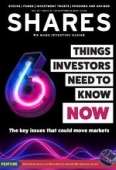Archived article
Please note that tax, investment, pension and ISA rules can change and the information and any views contained in this article may now be inaccurate.
Warning signals are mounting for markets as investors take fright

During the summer months it seemed like markets were playing a game of chicken with the US Federal Reserve, viewing any sign of weak economic news as ‘good’ in the hope it may convince the central bank to pause or even reverse its policy tightening.
But the Fed has been resolute in its message and actions. Its focus is on price stability and until it sees evidence of prices coming down meaningfully it will keep raising rates. August’s stickier than expected US consumer price inflation signaled more rate hikes are on the cards.
Research by the IMF (International Monetary Fund) shows that persistently high inflation can trigger an upward spiral in wages. This is a risk the Fed seemingly wants to avoid at all costs.
While the US central bank doesn’t want a pronounced downturn, it is walking a tight line between slowing inflation and pushing the world’s largest economy into outright recession.
Meanwhile other central banks have been singing from the same hymn sheet. The Swedish Riksbank surprised markets after hiking interest rates by a full percentage point (20 September) and warned more was to come.
Both the Bank of England and the European Central Bank are expected to continue increasing interest rates.
For the first time in decades it feels like central banks do not have investors’ backs. Effectively investors are looking at a regime change for interest rates after decades of falling borrowing costs.
The question is can the global economy handle higher borrowing costs on top of rising inflation and slower growth?
PROFIT WARNINGS ON THE RISE
There is increasing evidence that higher interest rates are staring to bite after numerous companies issued profit warnings in recent weeks.
One of the most significant warnings has come from transport and logistics company FedEx (FDX:NYSE). The firm is seen as a bellwether, giving advanced warning on the health of the global economy.
The company missed first quarter earnings estimates to the end of August by 33% and cut 2023 guidance.
Management laid the blame on slowing demand across the globe, creating a huge downdraft in its shares which fell 22% on the news, denting sentiment across markets.
What caught the attention was the suddenness of the slowdown. CEO Raj Subramaniam said: ‘Global volumes declined as macro-economic trends significantly worsened later in the quarter, both internationally and in the US.’
The drop in FedEx had a knock-on effect across the sector with the shares of UPS (UPS:NYSE), Royal Mail (RMG), and Deutsche Post (DPH:XETRA) all registering weakness.
A related sector theme which seems to be becoming a notable trend is the slowdown in e-commerce activity. German warehouse equipment maker Kion (KGX:XETRA) warned (14 Sep) on third-quarter profits after citing supply chain shortages and a sharp increase in raw material and energy prices.
The company now expects adjusted net income to be in the range of €200 million to €310 million, well below the €674 million expected by analysts. Significantly higher material, energy and logistics costs combined with weaker demand also led peer robotics company Autostore (AUTO:OSLO) to issue a profit warning (14 Sep).
Shares in the Norwegian company fell 12% to new all-time lows after saying it experienced cancellations from some e-commerce clients. The weakness in robotics players servicing e-commerce has clear implications for UK online retailer Ocado (OCDO). The shares fell 8% (14 September) after Credit Suisse downgraded the stock to underperform from neutral.
This followed a fall of 15% after its joint venture with Marks and Spencer (MKS), Ocado Retail, lowered full year guidance. The company said a combination of cost headwinds and customers trading down is impacting margins.
COMMODITY WEAKNESS
Another bellwether providing insight into the state of the global economy is the price of copper, which is why it is often referred to as Dr Copper.
Demand for copper is closely related to the strength of the world economy and recent price action is potentially worrying. After peaking in March, the price has dropped by around 30% while mining shares have also weakened.
THREAT POSED BY QUANTITATIVE TIGHTENING
The Fed started to shrink the size of its nearly $9 trillion balance sheet on 1 June by $45 billion per month. Since the start of September, it has increased to $90 billion per month.
This is known as QT (quantitative tightening) and as the name suggests it is intended to tighten financial market conditions. It is a reversal of quantitative easing where the Fed purchased assets from banks to increase banking sector liquidity.
While the precise effect of QT is unknown, (the Fed doesn’t provide guidance) it is generally thought to be equivalent to hiking rates.
Important information:
These articles are provided by Shares magazine which is published by AJ Bell Media, a part of AJ Bell. Shares is not written by AJ Bell.
Shares is provided for your general information and use and is not a personal recommendation to invest. It is not intended to be relied upon by you in making or not making any investment decisions. The investments referred to in these articles will not be suitable for all investors. If in doubt please seek appropriate independent financial advice.
Investors acting on the information in these articles do so at their own risk and AJ Bell Media and its staff do not accept liability for losses suffered by investors as a result of their investment decisions.

 magazine
magazine








